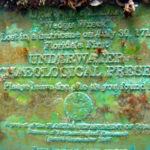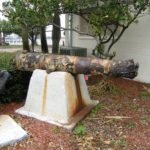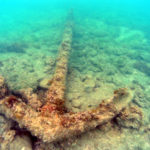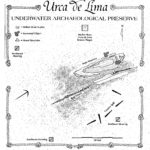Off Fort Pierce, Florida, reachable from shore, lie the remains of a Spanish sailing vessel lost in a terrible storm. When one thinks of Spanish ships, a galleon comes to mind. This vessel was not a galleon, but an urca, a wide-hulled ship for transporting cargo. It was named Urca de Lima for its owner, Miguel de Lima y Melo, and its hull was reinforced for long-distance trade.
History of the Urca de Lima
Urca de Lima was part of a flota, or convoy, that set sail in 1715 to deliver goods from Mexico and Manila, the far reaches of Spain’s empire, to Europe. In a time of uncertainty and piracy, the vessels traveled together for safety. Urca de Lima carried exotic cargos like sassafras and vanilla, and more everyday items like cowhides. It did not carry royal treasure, only private silver.
In July 1715, heavy winds from the north and northeast drove the flota relentlessly toward the coast. After the terrible storm, Miguel de Lima noted that his vessel was among the few to survive being battered ashore, and the store-ship played a key role in aiding the survivors. Soon other Spanish vessels reached them, and after salvage they burned Urca de Lima to the waterline to hide its position from English freebooters, who soon arrived looking for plunder.
The wreck, like much of the rest of the 1715 fleet, sank into the sand and faded from history. The wreck is mentioned again in the 1770s, when the British Crown sent marine surveyor Bernard Romans to map the newly-acquired territory of Florida. He and his men noted the shipwreck during their travels.
Modern salvage
Urca de Lima was lost for centuries until hard-hat diver William J. Beach rediscovered it in 1928. He raised cannons and anchors that visitors can still see at Ft. Pierce City Hall. At the time, knowledge of how to treat and conserve metal objects like cannons and anchors was limited. The items deteriorated over time and are currently in a sad state of disrepair. In 1932, the first salvage permit for Urca de Lima was granted. Salvagers visited the site throughout the 1950s and again in the 1980s. The hunt for treasure was not particularly fruitful, however, because the Spanish salvaged the vessel when it sank, and there was little in the way of treasure aboard in the first place. Treasure hunters did recover silver wedges, a silver bar, and a cannon. The site’s modern nickname is “The Wedge Wreck,” after the silver wedges.






Shipwreck as a preserve
The shipwreck is more than an example of a Spanish colonial vessel; it is also Florida’s first Underwater Archaeological Preserve. The dedication of Urca de Lima as a preserve was a decades-long process. The St. Lucie County Board of Commissioners sent the state a request to end salvage on Urca de Lima and petitioned to designate it as an archaeological preserve in 1968. Afraid of losing the site, the community was concerned that further salvage might destroy it, leaving nothing for divers to see.
In addition to the site’s historical value, they also saw it as a matter of tourism. Divers would not want to visit a site that had been destroyed by salvage. St. Lucie County was far ahead of its time in its thinking toward historic preservation, and the idea was shelved until the 1980s. Surveyed and mapped in 1985, the Urca de Lima finally became an Underwater Archaeological Preserve in 1987. All of Florida’s Underwater Archaeological Preserves have followed this first example. Waterfront communities always nominate preserves, rather than the state. Today Florida has 12 preserves, from Ft. Pierce south to the Florida Keys and west to Pensacola.
Diving the shipwreck
Urca de Lima is about two and a half miles (4 km) north of Fort Pierce Inlet. The site is 200 yards (180 m) offshore, in 10 to 15 feet (3 to 4.5 m) of water on the first offshore reef, approximately 1,000 yards (9,900 m) north of the Pepper Park boundary. Divers should use a “divers down” flag when visiting the site.
The remains of the Urca de Lima consist of a hull section emerging from the sand and undersea vegetation. West of the structure is a colonial anchor, placed at the site after looters tried to illegally remove it from an area to the north. The anchor dates to the same period as the shipwreck. South of the structure are five concrete replica cannons, now covered in a marine growth that makes them look like encrusted naval guns. North of the wooden remains is a concrete monument with an embedded bronze plaque that states the importance of the Preserve. In addition to the archaeology, visitors will find sea life such as sea urchins, sea cucumbers, flounder, wrasse and blue tang.
Remember, Florida’s historic shipwreck sites are protected. Souvenir hunting is prohibited. Please take only photos and leave only bubbles. To learn more about Florida’s Underwater Archaeological Preserves visit museumsinthesea.com.
By guest author Franklin Price
The post Florida’s Underwater Archaeological Preserves: The Urca de Lima appeared first on Scuba Diver Life.
from Scuba Diver Life https://ift.tt/2JChYVc
No comments:
Post a Comment